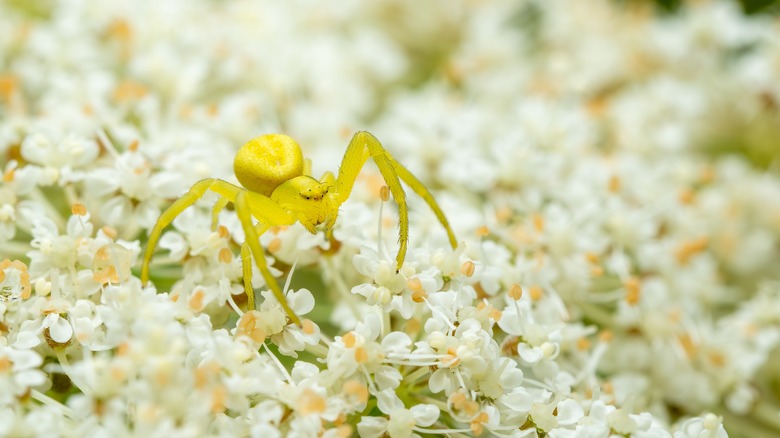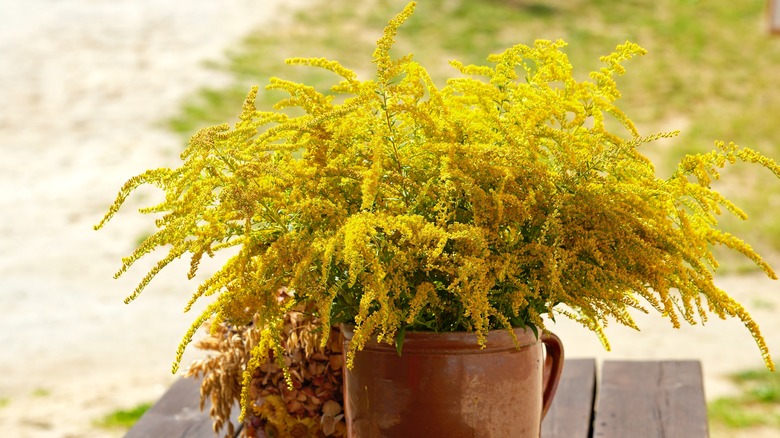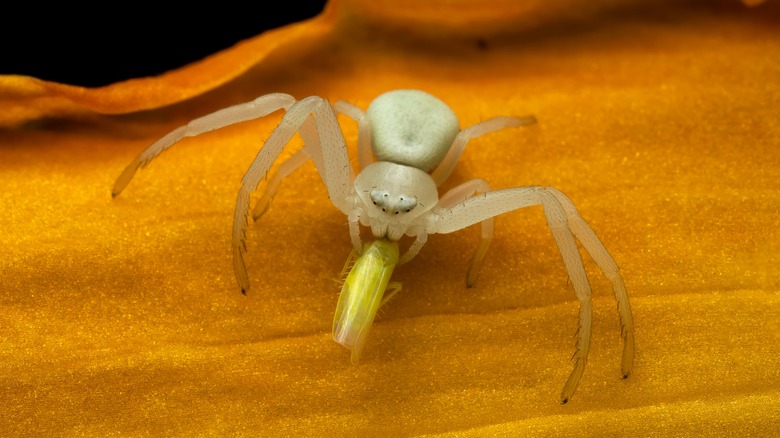The Flowers And Plants In Your Garden That Are Attracting Yellow Crab Spiders
Knowing which flowering perennials to plant for a stunning spring brings visual joys and benefits local ecology. You get to admire the vibrant blooms while providing food for a whole array of flying and crawling garden visitors. You might not, however, love all of your backyard insect visitors, especially those of the eight-legged variety. Crab spiders are particularly alarming since they tend to surprise their exoskeletal prey, their vibrant colors (like the yellow in the title of this article) camouflaging them on petals and amongst inflorescences. Unsuspecting gardeners bending down to smell the roses — or goldenrod, milkweed, daisies, and purple coneflower blooms, all of which are among the most popular of the many plants that crab spiders prefer — and spotting one of these sneaky spiders may get a bit of a fright.
There are about 3,000 species of crab spider worldwide, with a couple hundred of those found in North America. These opportunistic spiders, so called because they walk sideways like a crab and have long front legs, inhabit wild plots and suburban backyards alike, where they lie in wait and pounce on their insect prey. In other words, they're a beneficial pest that won't leave webs in your garden. Crab spiders also like to dine on nectar and pollen from time to time, perhaps another reason why they prefer flowering shrubs to trees or grasses. They're highly venomous, so much so that they eat enormous insects — relative to their 0.2 to 0.5-inch length, at least. There's no need to fear them, however; they rarely bite humans or pets, and when they do, they don't cause damage.
Flower crab spiders most often inhabit goldenrod and milkweed
Before we go any further, we need to clear something up. The name "yellow crab spider" is a bit misleading. It's an everyday name that could refer to any one of the many brown, green, pink, white, orange, or yellow Mecaphesa, Misumena, Misumenoides, and Misumessus species spiders, commonly known as flower crab spiders, in the Thomisidae family. For example, the whitebanded crab spider (Misumenoides formosipes) is yellow with black and white stripes. The goldenrod crab spider (Misumena vatia), one of the most common crab spider species in the U.S., might often appear yellow but it isn't always that hue. Incredibly, this eight-legged wonder can change its appearance to suit the color of whatever bloom it's decided to take up residence on. The reason is debated by experts: the camouflage might help them sneak up on their prey or avoid predation themselves. It takes a while, though, almost a month — though reversing back to white is quicker.
With that in mind, it's not hard to imagine that so-called yellow crab spiders could be attracted to an abundance of flowering plants. However, while they're opportunists, it's only to a degree. These hungry insectivores definitely prefer some plants over others. Chief among them is goldenrod (Solidago species), so much so that one species of crab spider adopts the moniker: the aforementioned goldenrod crab spider. It's followed closely by milkweed, a species the spiders also prefer to lay their eggs on; purple coneflowers (Echinacea purpurea); and numerous daisy or daisy-like plants, like yellow corn daisy (Glebionis segetum), ox-eye daisy (Leucanthemum vulgare), and anything in the Asteraceae family.
Flowering plants and crab spiders have a symbiotic relationship
Though flower crab spiders have preferences, they'll inhabit almost any bloom, particularly if the plant is native to the U.S. and yellow or white in hue — pretty much anything that attracts insects for them to eat. They've been spotted by naturalists, researchers, and home gardeners on daisy fleabanes, snapdragons, Queen Anne's lace, marigolds, sunflowers, black-eyed Susan, begonias, and yarrow. Some less expected plants include Pequin peppers, water hemlock, St. John's wort, and dogwood. In the wild, they favor areas filled with grass and flowering plants — think prairies and meadows full of wild bergamot and purple common mallow. In fact, it may be that color determines which plants crab spiders and, probably not coincidentally, their prey prefer, as revealed in this 2004 study published in Behavioral Ecology.
Whether you avoid planting the most favored is up for debate. While crab spiders do indeed prey on pollinators, they also eat pest insects like grasshoppers and katydids, reducing their populations over time. Studies have also shown that plants that host crab spiders produce more seeds from herbivore-munched seed heads. In other words, having them around is a net benefit — for gardeners and their vegetation. Evidence shows that when they sense an assault from aphids or some other insect on their buds, some flowering plants release a scent that calls crab spiders over for a feast. As you can see, you might want to think twice before trying to get rid of spiders in the garden. Experts even go so far as to enthusiastically promote boosting the number and variety of flowering plants in your garden.


